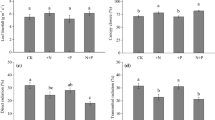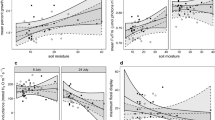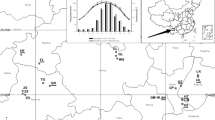Abstract
Interspecific differences in sapling growth responses to soil resources could influence species distributions across soil resource gradients. I calibrated models of radial growth as a function of light intensity and landscape-level variation in soil water and foliar N for saplings of four canopy tree species, which differ in adult distributions across soil resource gradients. Model formulations, characterizing different resource effects and modes of influencing growth, were compared based on relative empirical support using Akaike’s Information Criterion. Contrary to expectation, the radial growth of species associated with lower fertility (Acer rubrum and Quercus rubra) was more sensitive to variation in soil resources than the high fertility species Acer saccharum. Moreover, there was no species tradeoff between growth under high foliar N versus growth under low foliar N, which would be expected if growth responses to foliar N mediated distributions. In general, there was functional consistency among species in growth responses to light, foliar N, and soil water availability, respectively. Foliar N influenced primarily high-light growth in F. grandifolia, A. rubrum, and Q. rubra (but was not significant for A. saccharum). In A. saccharum and A. rubrum, for which soil water availability was a significant predictor, soil water and light availability simultaneously limited growth (i.e., either higher light or water increased growth). Simple resource-based models explained 0.74–0.90 of growth variance, indicating a high degree of determinism. Results suggest that nitrogen effects on forest dynamics would be strongest in high-light early successional communities but that water availability influences growth in both early successional and understory environments.






Similar content being viewed by others
References
Aber JD, Botkin DB, Melillo JM (1979) Predicting the effects of different harvesting regimes on productivity and yield in northern hardwoods. Can J For Res 9:10–14
Bigelow SW, Canham CD (2002) Community organization of tree species along soil gradients in a north-eastern USA forest. J Ecol 90:188–200
Bugmann H, Cramer W (1998) Improving the behaviour of forest gap models along drought gradients. For Ecol Man 103:247–263
Burnham KP, Anderson DR (2002) Model selection and multimodel inference, 2nd edn. Springer, New York
Burns RM, Honkala BH (1990) Silvics of North America: 2. Hardwoods. Agriculture Handbook 654. U.S. Department of Agriculture, Washington
Canham CD (1988) An index for understory light levels in and around canopy gaps. Ecology 69:1634–1638
Canham CD, Berkowitz AR, Kelly VR, Lovett GM, Ollinger SV, Schnurr J (1996) Biomass allocation and multiple resource limitation in tree seedlings. Can J For Res 26:1521–1530
Castello JD, Leopold DJ, Smallidge PJ (1995) Pathogens, patterns, and processes in forest ecosystems. Bioscience 45:16–24
Catovsky S, Bazzaz FA (2002) Nitrogen availability influences regeneration of temperate tree species in the understory seedling bank. Ecol Appl 12:1056–1070
Catovsky S, Kobe RK, Bazzaz FA (2002) Nitrogen-induced changes in seedling regeneration and dynamics of mixed conifer-broad-leaved forests. Ecol Appl 12:1611–1625
Cavender-Bares J, Bazzaz FA (2000) Changes in drought response strategies with ontogeny in Quercus rubra: implications for scaling from seedlings to mature trees. Oecologia 124:8–18
Clark JS, Mohan J, Dietze M, Ibanez I (2003) Coexistence: how to identify trophic trade-offs. Ecology 84:17–31
Cleland DT, Hart JB, Host GE, Pregitzer KS, Ramm CW (1990) Field guide: ecological classification and inventory system of the Huron-Manistee National Forests. US Department of Agriculture, Forest Service, Huron-Manistee, National Forest, Cadillac
Comas LH, Bouma TJ, Eissenstat DM (2002) Linking root traits to potential growth rate in six temperate tree species. Oecologia 132:34–43
Evans JR (1989) Photosynthesis and nitrogen relationships in leaves of C3 plants. Oecologia 78:9–19
Field C, Mooney HA (1986) The photosynthesis–nitrogen relationship in wild plants. In: Givnish TJ (ed) On the economy of plant form and function. Cambridge University Press, Cambridge, pp 25–55
Fine PVA, Mesones I, Coley PD (2004) Herbivores promote specialization by trees in Amazonian forests. Science 305:663–665
Finzi AC, Canham CD (2000) Sapling growth in response to light and nitrogen availability in a southern New England forest. For Ecol Man 131:153–165
Finzi AC, Van Breemen N, Canham CD (1998) Canopy tree soil interactions within temperate forests: species effects on soil carbon and nitrogen. Ecol Appl 8:440–446
Frazer GW, Canham CD, Lertzman KP (1999) Gap light analyzer (GLA): imaging software to extract canopy structure and gap light transmission indices from true color fisheye photographs, Users manual and program documentation. Simon Fraser University, Burnaby, British Columbia and Institute of Ecosystem Studies, Millbrook
Grubb PJ, Lee WG, Kollmann J, Wilson JB (1996) Interaction of irradiance and soil nutrient supply on growth of seedlings of ten European tall-shrub species and Fagus sylvatica. J Ecol 84:827–840
Host GE, Pregitzer KS (1992) Geomorphic influences on ground-flora and overstory composition in upland forests of northwestern lower Michigan. Can J For Res 22:1547–1555
Host GE, Pregitzer KS, Ramm CW, Lusch DP, Cleland DT (1988) Variation in overstory biomass among glacial landforms and ecological land units in northwestern lower Michigan. Can J For Res 18:659–668
Kobe RK (1996) Intraspecific variation in sapling mortality and growth predicts geographic variation in forest composition. Ecol Mon 66:181–201
Kobe RK, Pacala SW, Silander JA, Canham CD (1995) Juvenile tree survivorship as a component of shade tolerance. Ecol Appl 5:517–532
Kobe RK, Likens GE, Eagar C (2002) Tree seedling growth and mortality responses to manipulations of calcium and aluminum in a northern hardwood forest. Can J For Res 32:954–966
Kolb TE, Steiner KC, Mccormick LH, Bowersox TW (1990) Growth-response of northern red-oak and yellow-poplar seedlings to light, soil-moisture and nutrients in relation to ecological strategy. For Ecol Man 38:65–78
Latham RE (1992) Co-occurring tree species change rank in seedling performance with resources varied experimentally. Ecology 73:2129–2144
Leak WB (1978) Relationship of forest vegetation to habitat on two types of glacial drift in New Hampshire. Forest Service Research Note NE-257. US Department of Agriculture, Forest Service, Northeast Forest Experiment Station, Broomall
Lusk CH, Contreras O, Figueroa J (1997) Growth, biomass allocation and plant nitrogen concentration in Chilean temperate rainforest tree seedlings: effects of nutrient availability. Oecologia 109:49–58
MacFarlane DW, Kobe RK (2001) Selecting models for capturing tree size effects on growth-resource relationships. Can J For Res (in review)
McFadden JP, Macdonald NW, Witter JA, Zak DR (1994) Fine-textured soil bands and oak forest productivity in northwestern lower Michigan, USA. Can J For Res 24:928–933
Meziane D, Shipley B (1999) Interacting components of interspecific relative growth rate: constancy and change under differing conditions of light and nutrient supply. Func Ecol 13:611–622
Montague TG, Givnish TJ (1996) Distribution of black spruce versus eastern larch along peatland gradients: relationship to relative stature, growth rate, and shade tolerance. Can J Bot 74:1514–1532
Nicotra AB, Babicka N, Westoby M (2002) Seedling root anatomy and morphology: an examination of ecological differentiation with rainfall using phylogenetically independent contrasts. Oecologia 130:136–145
Pacala SW, Canham CD, Silander JA, Kobe RK (1994) Sapling growth as a function of resources in a north temperate forest. Can J For Res 24:2172–2183
Pacala SW, Canham CD, Saponara J, Silander JA, Kobe RK, Ribbens E (1996) Forest models defined by field measurements: estimation, error analysis and dynamics. Ecol Mon 66:1–43
Pastor J, Aber JD, McClaugherty CA, Melillo JM (1984) Above-ground production and N and P cycling along a nitrogen mineralization gradient on Blackhawk Island, Wisconsin. Ecology 65:256–268
Reich PB, Walters MB, Ellsworth DS (1997) From tropics to tundra: global convergence in plant functioning. Proc Natl Acad Sci (USA) 94:13730–13734
Ripullone F, Lauteri M, Grassi G, Amato M, Borghetti M (2004) Variation in nitrogen supply changes water-use efficiency of Pseudotsuga menziesii and Populus×euroamericana; a comparison of three approaches to determine water-use efficiency. Tree Phys 24:671–679
Sack L, Grubb PJ (2002) The combined impacts of deep shade and drought on the growth and biomass allocation of shade-tolerant woody seedlings. Oecologia 131:175–185
Schreeg LA, Kobe RK, Walters MB (2005) Tree seedling growth, survival and morphology in response to landscape-level variation in soil resource availability in northern Michigan. Can J For Res 35:263–273
Schwarz PA, Fahey TJ, McCulloch CE (2003) Factors controlling spatial variation of tree species abundance in a forested landscape. Ecology 84:1862–1878
van Breemen N, Finzi AC, Canham CD (1997) Canopy tree–soil interactions within temperate forests: effects of soil elemental composition and texture on species distributions. Can J For Res 27:1110–1116
Walters MB, Reich PB (1996) Are shade tolerance, survival, and growth linked? Low light and, nitrogen effects on hardwood seedlings. Ecology 77:841–853
Walters MB, Reich PB (1997) Growth of Acer saccharum seedlings in deeply shaded understories of northern Wisconsin: effects of nitrogen and water availability. Can J For Res 27:237–247
Walters MB, Reich PB (1999) Low-light carbon balance and shade tolerance in the seedlings of woody plants: do winter deciduous and broad-leaved evergreen species differ? New Phyt 143:143–154
Whitney GG (1991) Relation of plant-species to substrate, landscape position, and aspect in north central Massachusetts. Can J For Res 21:1245–1252
Zak DR, Host GE, Pregitzer KS (1989) Regional variability in nitrogen mineralization, nitrification, and overstory biomass in northern lower Michigan. Can J For Res 19:1521–1526
Acknowledgements
Financial support from NSF (DEB 9729245, DEB 0075472) and McIntire-Stennis (Project MICL01871) made this research possible. Matt Sands and Pat Fowler of the US Forest Service helped me locate field sites. I thank Sarah Synowiec for her hard work in the field and lab and Will Erickson for completing the tree ring measurements. I wrote the first draft of this MS while on sabbatical at Northern Arizona University (Biology and Forestry) and The Arboretum at Flagstaff and gratefully acknowledge the support of these institutions. This MS was improved by critical reviews from Meera Iyer, Sarah McCarthy, Michael Walters, Steve Rewa, and Steve Hart’s lab group at NAU. Experiments in this paper comply with current laws in the USA.
Author information
Authors and Affiliations
Corresponding author
Additional information
Communicated by Louis Pitelka
Rights and permissions
About this article
Cite this article
Kobe, R.K. Sapling growth as a function of light and landscape-level variation in soil water and foliar nitrogen in northern Michigan. Oecologia 147, 119–133 (2006). https://doi.org/10.1007/s00442-005-0252-8
Received:
Accepted:
Published:
Issue Date:
DOI: https://doi.org/10.1007/s00442-005-0252-8




